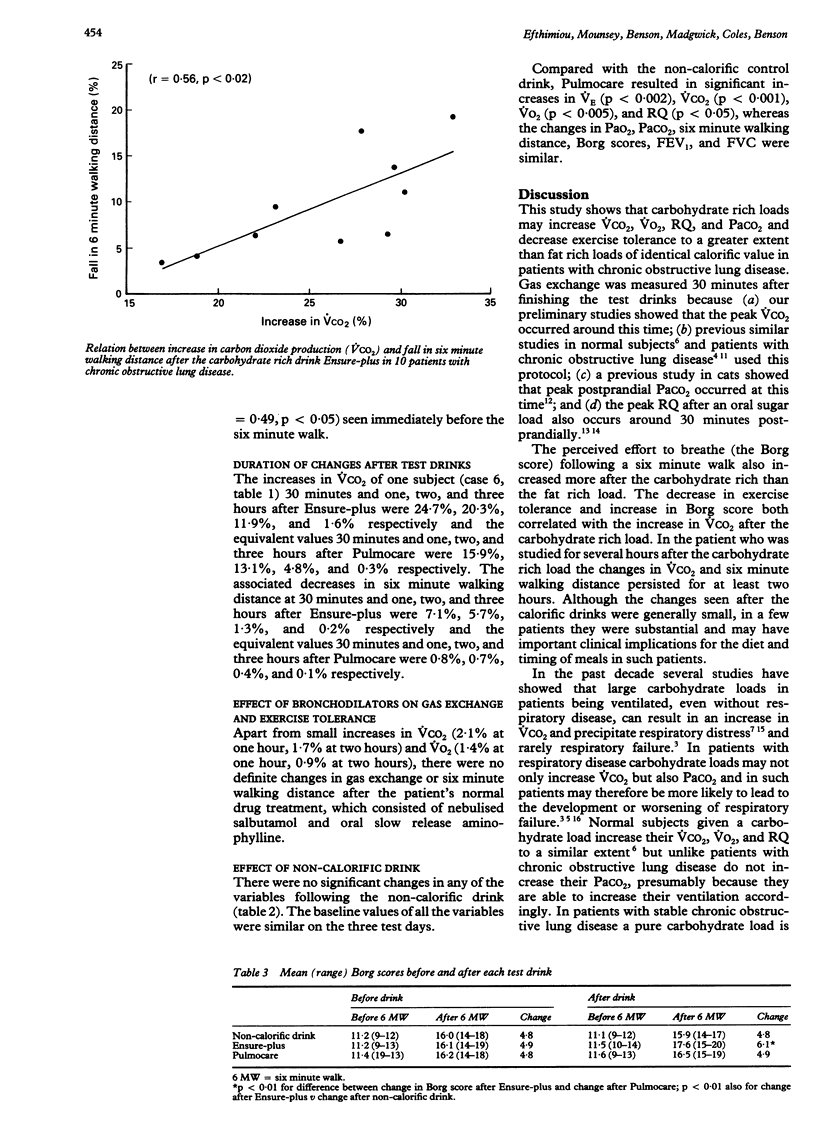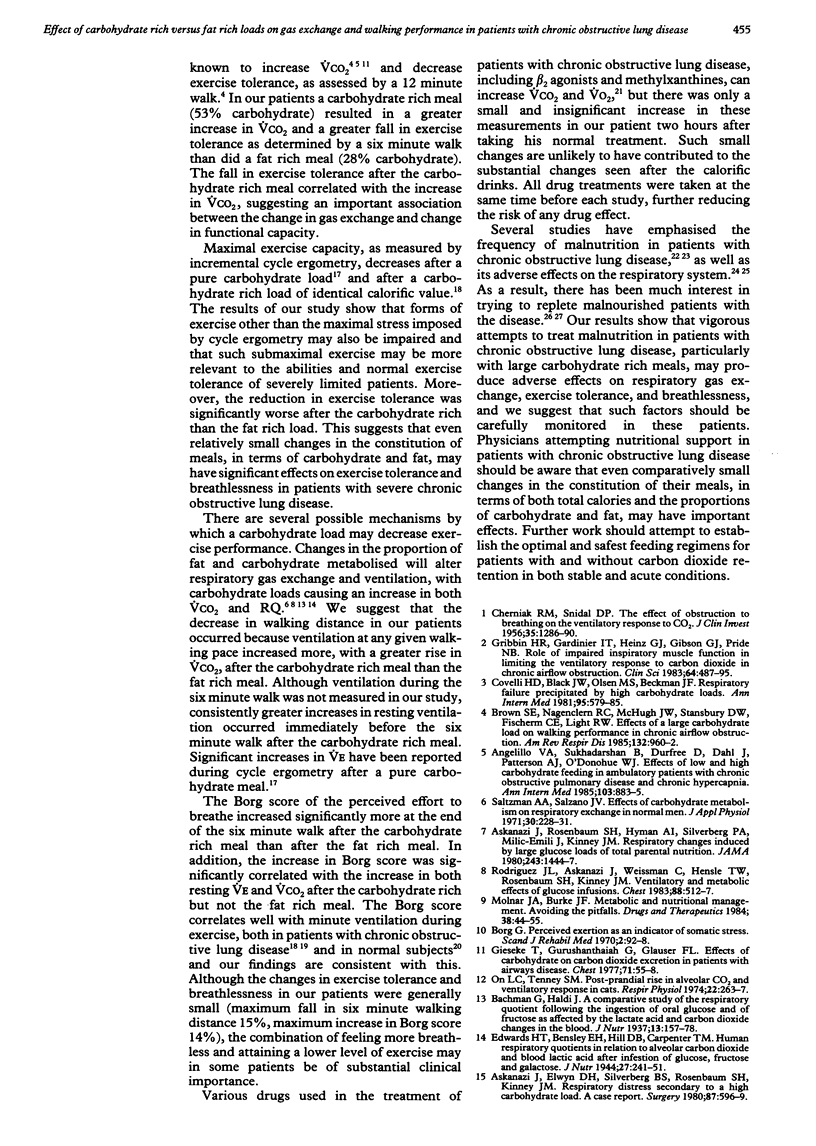Abstract
BACKGROUND: High calorie intakes, especially as carbohydrate, increase carbon dioxide production (VCO2) and may precipitate respiratory failure in patients with severe pulmonary disease. Energy obtained from fat results in less carbon dioxide and thus may permit a reduced level of alveolar ventilation for any given arterial blood carbon dioxide tension (PaCO2). METHODS: Ten patients with stable severe chronic obstructive lung disease underwent a six minute walk before and 45 minutes after taking 920 kcal of a fat rich drink, an isocalorific amount of a carbohydrate rich drink, and an equal volume of a non-calorific control liquid on three separate days, in a double blind randomised crossover study. Borg scores of the perceived effort to breathe were measured at the beginning and end of each six minute walk. Minute ventilation (VE2), VCO2, oxygen consumption (VO2), respiratory quotient (RQ), arterial blood gas tensions, and lung function were measured before and 30 minutes after each test drink. RESULTS: Baseline measurements were similar on all three test days and the non-calorific control drink resulted in no changes in any of the measured variables. The carbohydrate rich drink resulted in significantly greater increases in VE, VCO2, VO2, RQ, PaCO2, and Borg score and a greater fall in the distance walked in six minutes than the fat rich drink (mean fall after carbohydrate rich drink 17 m v 3 m after fat rich drink and the non-calorific control). The increase in VCO2 correlated significantly with the decrease in six minute walking distance and the increase in Borg score after the carbohydrate rich drink. The only significant change after the fat rich drink when compared with the non-calorific control was an increase in VCO2. CONCLUSIONS: Comparatively small changes in the carbohydrate and fat constitution of meals can have a significant effect on VCO2, exercise tolerance, and breathlessness in patients with chronic obstructive lung disease.
Full text
PDF





Selected References
These references are in PubMed. This may not be the complete list of references from this article.
- Adams L., Chronos N., Lane R., Guz A. The measurement of breathlessness induced in normal subjects: validity of two scaling techniques. Clin Sci (Lond) 1985 Jul;69(1):7–16. doi: 10.1042/cs0690007. [DOI] [PubMed] [Google Scholar]
- Angelillo V. A., Bedi S., Durfee D., Dahl J., Patterson A. J., O'Donohue W. J., Jr Effects of low and high carbohydrate feedings in ambulatory patients with chronic obstructive pulmonary disease and chronic hypercapnia. Ann Intern Med. 1985 Dec;103(6 ):883–885. doi: 10.7326/0003-4819-103-6-883. [DOI] [PubMed] [Google Scholar]
- Arora N. S., Rochester D. F. Respiratory muscle strength and maximal voluntary ventilation in undernourished patients. Am Rev Respir Dis. 1982 Jul;126(1):5–8. doi: 10.1164/arrd.1982.126.1.5. [DOI] [PubMed] [Google Scholar]
- Askanazi J., Elwyn D. H., Silverberg P. A., Rosenbaum S. H., Kinney J. M. Respiratory distress secondary to a high carbohydrate load: a case report. Surgery. 1980 May;87(5):596–598. [PubMed] [Google Scholar]
- Askanazi J., Rosenbaum S. H., Hyman A. I., Silverberg P. A., Milic-Emili J., Kinney J. M. Respiratory changes induced by the large glucose loads of total parenteral nutrition. JAMA. 1980 Apr 11;243(14):1444–1447. [PubMed] [Google Scholar]
- BOUSHY S. F., ADHIKARI P. K., SAKAMOTO A., LEWIS B. M. FACTORS AFFECTING PROGNOSIS IN EMPHYSEMA. Dis Chest. 1964 Apr;45:402–411. doi: 10.1378/chest.45.4.402. [DOI] [PubMed] [Google Scholar]
- Borg G. Perceived exertion as an indicator of somatic stress. Scand J Rehabil Med. 1970;2(2):92–98. [PubMed] [Google Scholar]
- Brown S. E., Nagendran R. C., McHugh J. W., Stansbury D. W., Fischer C. E., Light R. W. Effects of a large carbohydrate load on walking performance in chronic air-flow obstruction. Am Rev Respir Dis. 1985 Nov;132(5):960–962. doi: 10.1164/arrd.1985.132.5.960. [DOI] [PubMed] [Google Scholar]
- Brown S. E., Wiener S., Brown R. A., Marcarelli P. A., Light R. W. Exercise performance following a carbohydrate load in chronic airflow obstruction. J Appl Physiol (1985) 1985 Apr;58(4):1340–1346. doi: 10.1152/jappl.1985.58.4.1340. [DOI] [PubMed] [Google Scholar]
- CHERNIACK R. M., SNIDAL D. P. The effect of obstruction to breathing on the ventilatory response to CO2. J Clin Invest. 1956 Nov;35(11):1286–1290. doi: 10.1172/JCI103383. [DOI] [PMC free article] [PubMed] [Google Scholar]
- Covelli H. D., Black J. W., Olsen M. S., Beekman J. F. Respiratory failure precipitated by high carbohydrate loads. Ann Intern Med. 1981 Nov;95(5):579–581. doi: 10.7326/0003-4819-95-5-579. [DOI] [PubMed] [Google Scholar]
- Dark D. S., Pingleton S. K., Kerby G. R. Hypercapnia during weaning. A complication of nutritional support. Chest. 1985 Jul;88(1):141–143. doi: 10.1378/chest.88.1.141. [DOI] [PubMed] [Google Scholar]
- Efthimiou J., Fleming J., Gomes C., Spiro S. G. The effect of supplementary oral nutrition in poorly nourished patients with chronic obstructive pulmonary disease. Am Rev Respir Dis. 1988 May;137(5):1075–1082. doi: 10.1164/ajrccm/137.5.1075. [DOI] [PubMed] [Google Scholar]
- Gieseke T., Gurushanthaiah G., Glauser F. L. Effects of carbohydrates on carbon dioxide excretion in patients with airway disease. Chest. 1977 Jan;71(1):55–58. doi: 10.1378/chest.71.1.55. [DOI] [PubMed] [Google Scholar]
- Gribbin H. R., Gardiner I. T., Heinz G. J., 3rd, Gibson G. J., Pride N. B. Role of impaired inspiratory muscle function in limiting the ventilatory response to carbon dioxide in chronic airflow obstruction. Clin Sci (Lond) 1983 May;64(5):487–495. doi: 10.1042/cs0640487. [DOI] [PubMed] [Google Scholar]
- Hunter A. M., Carey M. A., Larsh H. W. The nutritional status of patients with chronic obstructive pulmonary disease. Am Rev Respir Dis. 1981 Oct;124(4):376–381. doi: 10.1164/arrd.1981.124.4.376. [DOI] [PubMed] [Google Scholar]
- Javaheri S., Guerra L. Lung function, hypoxic and hypercapnic ventilatory responses, and respiratory muscle strength in normal subjects taking oral theophylline. Thorax. 1990 Oct;45(10):743–747. doi: 10.1136/thx.45.10.743. [DOI] [PMC free article] [PubMed] [Google Scholar]
- Ou L. C., Tenney S. M. Post-prandial rise in alveolar CO2 and ventilatory response in cats. Respir Physiol. 1974 Dec;22(3):263–268. doi: 10.1016/0034-5687(74)90076-0. [DOI] [PubMed] [Google Scholar]
- Rodriguez J. L., Askanazi J., Weissman C., Hensle T. W., Rosenbaum S. H., Kinney J. M. Ventilatory and metabolic effects of glucose infusions. Chest. 1985 Oct;88(4):512–518. doi: 10.1378/chest.88.4.512. [DOI] [PubMed] [Google Scholar]
- Saltzman H. A., Salzano J. V. Effects of carbohydrate metabolism upon respiratory gas exchange in normal men. J Appl Physiol. 1971 Feb;30(2):228–231. doi: 10.1152/jappl.1971.30.2.228. [DOI] [PubMed] [Google Scholar]
- Silverman M., Barry J., Hellerstein H., Janos J., Kelsen S. Variability of the perceived sense of effort in breathing during exercise in patients with chronic obstructive pulmonary disease. Am Rev Respir Dis. 1988 Jan;137(1):206–209. doi: 10.1164/ajrccm/137.1.206. [DOI] [PubMed] [Google Scholar]
- Stark R. D., Gambles S. A., Chatterjee S. S. An exercise test to assess clinical dyspnoea: estimation of reproducibility and sensitivity. Br J Dis Chest. 1982 Jul;76(3):269–278. [PubMed] [Google Scholar]
- Wilson D. O., Rogers R. M., Sanders M. H., Pennock B. E., Reilly J. J. Nutritional intervention in malnourished patients with emphysema. Am Rev Respir Dis. 1986 Oct;134(4):672–677. doi: 10.1164/arrd.1986.134.4.672. [DOI] [PubMed] [Google Scholar]
- Zelinger A. B., Shulruff S., Pouget J. M. Significant left main stenosis following asymptomatic dissection during coronary arteriography. Chest. 1983 Mar;83(3):568–569. doi: 10.1378/chest.83.3.568. [DOI] [PubMed] [Google Scholar]


